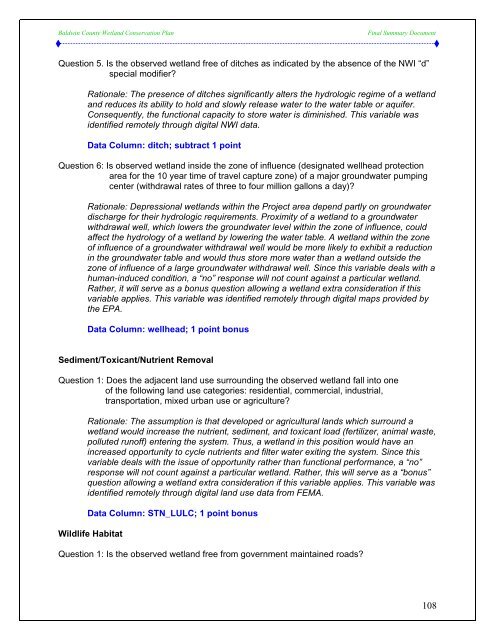Baldwin County Wetland Conservation Plan - Alabama Department ...
Baldwin County Wetland Conservation Plan - Alabama Department ...
Baldwin County Wetland Conservation Plan - Alabama Department ...
Create successful ePaper yourself
Turn your PDF publications into a flip-book with our unique Google optimized e-Paper software.
<strong>Baldwin</strong> <strong>County</strong> <strong>Wetland</strong> <strong>Conservation</strong> <strong>Plan</strong> Final Summary Document<br />
Question 5. Is the observed wetland free of ditches as indicated by the absence of the NWI “d”<br />
special modifier?<br />
Rationale: The presence of ditches significantly alters the hydrologic regime of a wetland<br />
and reduces its ability to hold and slowly release water to the water table or aquifer.<br />
Consequently, the functional capacity to store water is diminished. This variable was<br />
identified remotely through digital NWI data.<br />
Data Column: ditch; subtract 1 point<br />
Question 6: Is observed wetland inside the zone of influence (designated wellhead protection<br />
area for the 10 year time of travel capture zone) of a major groundwater pumping<br />
center (withdrawal rates of three to four million gallons a day)?<br />
Rationale: Depressional wetlands within the Project area depend partly on groundwater<br />
discharge for their hydrologic requirements. Proximity of a wetland to a groundwater<br />
withdrawal well, which lowers the groundwater level within the zone of influence, could<br />
affect the hydrology of a wetland by lowering the water table. A wetland within the zone<br />
of influence of a groundwater withdrawal well would be more likely to exhibit a reduction<br />
in the groundwater table and would thus store more water than a wetland outside the<br />
zone of influence of a large groundwater withdrawal well. Since this variable deals with a<br />
human-induced condition, a “no” response will not count against a particular wetland.<br />
Rather, it will serve as a bonus question allowing a wetland extra consideration if this<br />
variable applies. This variable was identified remotely through digital maps provided by<br />
the EPA.<br />
Data Column: wellhead; 1 point bonus<br />
Sediment/Toxicant/Nutrient Removal<br />
Question 1: Does the adjacent land use surrounding the observed wetland fall into one<br />
of the following land use categories: residential, commercial, industrial,<br />
transportation, mixed urban use or agriculture?<br />
Rationale: The assumption is that developed or agricultural lands which surround a<br />
wetland would increase the nutrient, sediment, and toxicant load (fertilizer, animal waste,<br />
polluted runoff) entering the system. Thus, a wetland in this position would have an<br />
increased opportunity to cycle nutrients and filter water exiting the system. Since this<br />
variable deals with the issue of opportunity rather than functional performance, a “no”<br />
response will not count against a particular wetland. Rather, this will serve as a “bonus”<br />
question allowing a wetland extra consideration if this variable applies. This variable was<br />
identified remotely through digital land use data from FEMA.<br />
Data Column: STN_LULC; 1 point bonus<br />
Wildlife Habitat<br />
Question 1: Is the observed wetland free from government maintained roads?<br />
108

















